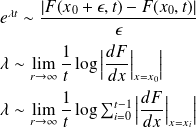Lyapunov Exponent
The Lyapunov exponent, measures how quickly an infinitesimally small distance between two initially close states grows over time.
The left hand side is the distance between two initially close states after
 steps, and the right hand side is the assumption that the distance grows exponentially over time. The Lyapunov exponent which is measured for long period of time corresponds to the exponent
steps, and the right hand side is the assumption that the distance grows exponentially over time. The Lyapunov exponent which is measured for long period of time corresponds to the exponent
 . The stability of the system is given by the sign of
. The stability of the system is given by the sign of
 . If
. If
 : means that s small distance grow with time, this corresponds to the stretching mechanism. And if
: means that s small distance grow with time, this corresponds to the stretching mechanism. And if
 : small distance do not grow indefinitely.The expression of
: small distance do not grow indefinitely.The expression of
 is obtained by doing some mathematical derivation, as follows:
is obtained by doing some mathematical derivation, as follows:

Taking the example of non-linear equation described above, we can calculate the Lyapunov exponent for different values of
 :
:
We can observe that the system becomes chaotic from a certain value of
 . The reader can play with different values of
. The reader can play with different values of
 by using the following code source.
by using the following code source.

: yacine.mezemate
"""import numpy as npimport matplotlib.pyplot as pltglobal x0, rx0 = 0 # Initial conditionr = np.linspace(0,2,200) # Parameter r# Differential equationdef F(x0,r): x = np.zeros((100,200)) for j in range(0,200): x[0,j] = x0 for i in range(0,99): x[i+1,j] = x[i,j] + r[j] - x[i,j]**2 return x # Derivativedef dF(x): dy = np.log(abs(1-x*2)) return dy# Lyapunov exponent def Lyapunov(dy): Lambda = np.mean(dy, axis =0) return Lambda # main y = F(x0,r)dy = dF(y)lam = Lyapunov(dy)# PLotplt.plot(r,lam)plt.plot([0,2], [0,0], "--")plt.xlabel("r", fontsize =18)plt.ylabel("Lyapunov exponent $\lambda$", fontsize =18)




